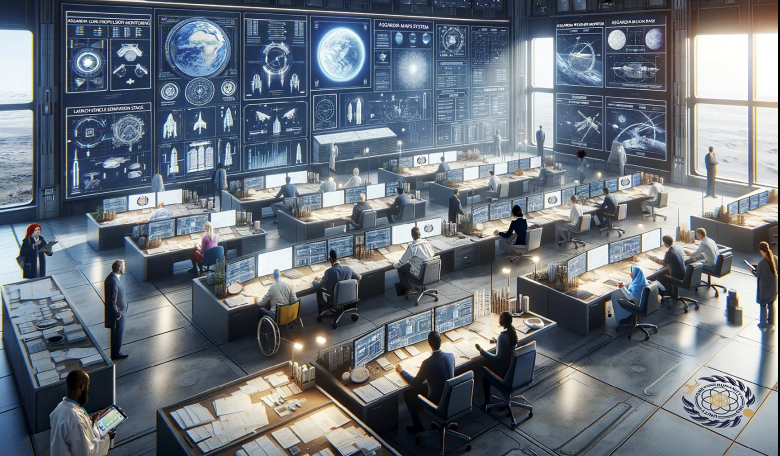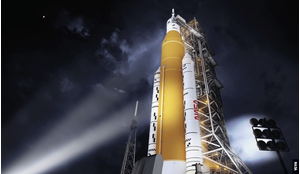If we are to establish permanent communities in Earth orbit or beyond, the development of in-space manufacturing will be crucial. Here, the authors discuss the administrative systems and standards designed to ensure that Asgardia, the space nation, will meet the requirements of building not only structures and facilities, but a nation in space.
Asgardia the space nation is committed to preparing humanity for a future living beyond Earth. A key pillar to this vision is manufacturing. In the harsh and unforgiving environment of space, robust, secure and sustainable manufacturing processes are crucial. The ambitious goal of preparing humanity for living and working in space, not just for a select few, but for everyone, requires a manufacturing infrastructure that can handle the challenges of space and is capable of producing everything from food and water to habitats and spacecraft. This encompasses more than manufacturing; it is about focusing on the needs and goals of people.
To achieve this, the Asgardia Ministry of Manufacturing and the Parliamentary Manufacturing Committee is developing three foundations under the following organisations.
First, the Asgardia Institute of Standards (AIS) defines and maintains standards that ensure compatibility and interoperability across different systems and components, while its sister organisation, the Institute of Asgardia for the Assurance of Compliance and Quality (ACQia), assists in the application of Asgardian Standards and provides compliancy checks. No single nation can handle the immense task of building space infrastructure alone, so there is a need for international collaboration and standards are a prerequisite of such collaboration.
Second, the Asgardia Manufacturing & Integration Approach (AMIA) is a framework for integrating diverse manufacturing capabilities into a cohesive whole. Fortunately, Earth’s existing technological advancements provide a plethora of products, systems and services, and Asgardia recognises that it must focus on integration to truly thrive.
Third, the Asgardia Project Coordination Institute (APCI) plays a vital role in making AMIA a reality. This institute oversees the selection, management and evaluation of projects within Asgardia, by ensuring that projects are coordinated and their manufacturing aspects are aligned with AMIA principles. The APCI helps to accelerate the development of the critical infrastructure needed for a flourishing spacefaring society.
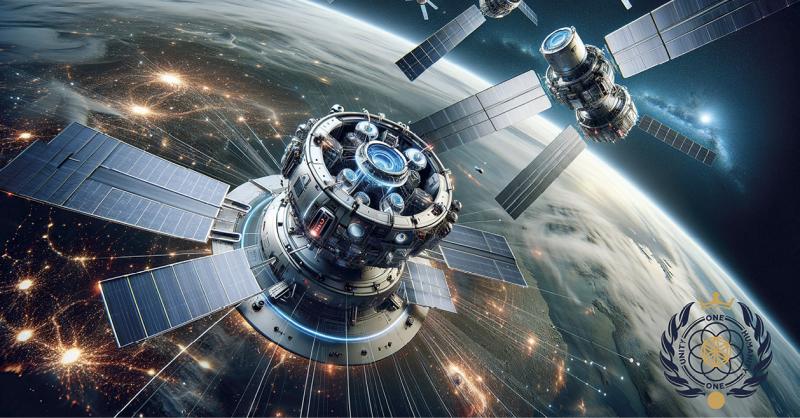 A swarm architecture will be needed to support sustainable living and working in space
A swarm architecture will be needed to support sustainable living and working in space
The need for AMIA
Asgardia is committed to preparing humanity for a future living beyond Earth
Space manufacturing presents unique challenges. The environment is tough, resources are limited and products and services must be robust, secure and sustainable. Additionally, the sheer vastness of space necessitates a modular and agile approach to manufacturing; traditional, centralised methods simply won’t suffice.
This requires a new approach and a new standard. The Asgardia Manufacturing & Integration Approach addresses these challenges by focusing on the following key principles:
- Integration: seamless integration of diverse manufacturing capabilities is essential for efficiency and adaptability, bringing together diverse components, systems and services to create a cohesive whole
- Robustness: products and services must be able to withstand the harsh space environment
- Security: secure manufacturing processes are crucial for protecting critical resources and infrastructure; secure by design is the default
- Sustainability: manufacturing must be environmentally responsible and resource-efficient, and products and services must be made for a circular economy
- Modularity: a modular approach allows for flexibility and scalability in space environments, using standardised parts that can be easily integrated, reused and reconfigured
- Agility: quick adaptation to changing circumstances, needs and conditions is essential for success in space
- Professionalism: a professional approach, employing the highest standards of engineering and craftsmanship, ensures high-quality products and services
- Business Focus: profitability is necessary for creating long-term sustainability and profitable ventures in space.
AMIA is the cornerstone of Asgardia’s manufacturing strategy. It emphasises a keen focus on professional and business needs and supports the ‘as a service’ methodology, encouraging a holistic and evolutionary approach.
Collaboration is the key to success and manufacturing uses profit as an incentive to drive innovation and growth. This collaborative effort will involve a network of consumers, producers and ‘prosumers’ (a combination of both). They will work together in a multi-market approach to build a circular, sustainable and thriving space economy.
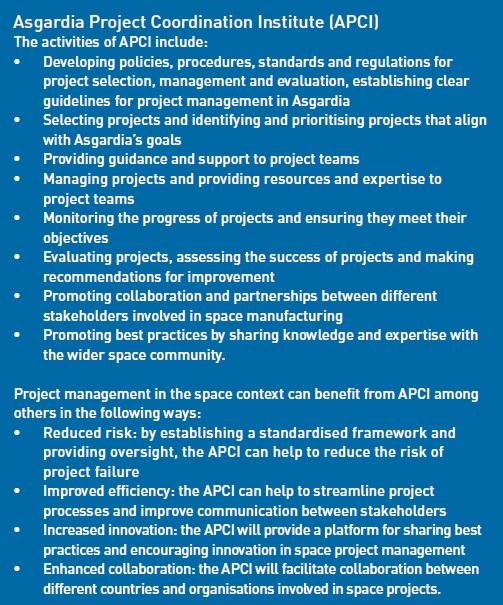
Putting theory into practice
In the harsh and unforgiving environment of space, robust, secure and sustainable manufacturing processes are crucial
Beyond standards and a manufacturing approach, Asgardia needs a framework for effectively executing projects and programmes. The Asgardian Project Management Framework (APMF) will fill this gap, providing a structured approach that prioritises integration, quality and compliance with established standards. It is developed to guide the execution of complex projects in the space environment. The framework focuses on:
- Coordination - ensuring all stakeholders are working together effectively
- Quality - delivering projects that meet the highest standards
- Compliance - adherence to relevant standards, regulations and best practices
- Sustainability - building infrastructure that can be maintained and expanded over time.
To oversee the implementation of the APMF standard, and ensure that all projects align with Asgardia’s ultimate goal of living and working in space, the Asgardia Project Coordination Institute (APCI) has been established. This institute acts as the central hub for project management, providing support and guidance to project teams. It also ensures that manufacturing aspects are aligned with AMIA principles. This institute will play a crucial role in ensuring that Asgardia’s ambitious goals are achieved (see Box).
Building a nation for the future
Living and working in space requires far more than that offered, for example, by the International Space Station. Asgardia envisions numerous space cities, each housing at least 10,000 inhabitants, establishing a permanent human presence beyond Earth. Such cities could be located on the Moon, Mars, the moons of Jupiter, or even floating freely in space.
This is a monumental task, but the potential rewards are great. Asgardia’s manufacturing ambitions go beyond simply creating products and services. They are about building a nation - Asgardia, the Space Nation. This requires a comprehensive ecosystem encompassing various sectors including services for energy, logistics, manufacturing, safety and security, information/communications/knowledge, operations/monitoring/support, human resources, finance, science, habitat, citizenship and coherence.
Asgardia intends to leverage integration and manufacturing to build this complex ecosystem, which means focusing on overarching systems, with multi-dimensional architectures, not on individual components. In Asgardia, we think on the scale of a Space Nation, transcending national systems. The finance market provides an example: instead of creating something with the dimension of individual ATMs or a national credit card service, Asgardia seeks to – indeed needs to - develop a system like SWIFT, the global secure interbank messaging system.
Pillars of success
Beyond standards and a manufacturing approach, Asgardia needs a framework for effectively executing projects and programmes
In the vast and demanding theatre of space manufacturing, the implementation of the Asgardia Manufacturing & Integration Approach (AMIA) and the Asgardia Project Coordination Institute (APCI) requires a profound reflection on professionalism, excellence in trades and adherence to best practices. These elements are not just components of our work; they are its foundation, ensuring the success and sustainability of our endeavours in space.
Professionalism, in the context of AMIA and APCI, goes beyond mere competence. It is about a culture of excellence, integrity and responsibility. Each professional involved, whether an engineer, technician, project manager or researcher, must embody these values. This demand for professionalism ensures that every task, big or small, is carried out with the highest degree of precision and dedication.
The mastery of trades plays a crucial role. Each trade, whether it’s system design, manufacturing, logistics or project management, must be practiced by individuals who are not only qualified but also passionate and continually engaged in improving their skills. This mastery ensures that the solutions we develop are not only innovative but also reliable and suited to the unique challenges of the space environment.
 Asgardia provides an approach, standards and project coordination to enable sustainable international collaboration needed for robust integration and manufacturing.
Asgardia provides an approach, standards and project coordination to enable sustainable international collaboration needed for robust integration and manufacturing.
Adherence to best practices is another fundamental pillar. In a field where the margins for error are minimal and the consequences of failure potentially catastrophic, respecting best practices is not an option, but an obligation. This involves a thorough knowledge and application of the best international practices, standards and regulations.
AMIA and APCI, as institutions, must embody and promote these principles of professionalism, mastery of trades and adherence to best practices. This requires continuous training programmes, mentoring systems and professional development opportunities for all employees. Furthermore, a culture of knowledge exchange and experience sharing within these institutions and with their partners is essential to maintain a high level of competence and expertise.
These principles are the pillars on which the success of our space ambitions rests. They ensure that each project, innovation and achievement contributes significantly to our ultimate goal: establishing a sustainable and prosperous human presence in space.
Effective governance
Asgardia envisions numerous space cities, each housing at least 10,000 inhabitants, establishing a permanent human presence beyond Earth
In the realm of Asgardia’s pioneering space governance, a unique challenge emerges: how to balance the rigidity of processes with the flexibility of good practices. This intriguing juxtaposition forms the core of our exploration, revealing how these seemingly opposing elements can, in reality, weave together to form a cohesive and beneficial framework for the organisation.
At the heart of Asgardia’s administrative governance lies its commitment to well-defined processes, which are the lifeblood of consistency and quality, ensuring that every action taken aligns with the high standards Asgardia upholds. They are, should and will be meticulously crafted to minimise risks, streamline efficiency and optimise resource utilisation. By providing a clear roadmap, these processes empower members of Asgardia to perform with confidence and precision.
Parallel to this structured approach are the rules of good practices. These are the softer, more adaptable guidelines that provide the necessary elbow room for innovation and creativity. In the fast-evolving landscape of space governance, these practices will allow for quick adaptation, encouraging Asgardians to think outside the box and tailor their solutions to unique challenges.
To bring these concepts to life, we delve into real-life scenarios from within Asgardia. Here, we see how strict adherence to processes leads to successful outcomes in complex projects. Conversely, we explore instances where the flexibility of good practices ignites innovation, solving problems in ways that rigid structures could not accommodate. We also draw parallels with terrestrial organisations, where similar principles are applied in corporate governance. These comparisons not only validate our approaches but also offer fresh perspectives and lessons that can be integrated into Asgardia’s unique context. As a result, real applications lead to real insights, for the benefit of all that take this journey with us.
A significant takeaway from our exploration is the importance of continuous learning and adaptation. Asgardia champions the idea that governance is not a static construct but a dynamic interplay of structured processes and evolving practices. Regular training, awareness programmes, and the willingness to revise and adapt are highlighted as key to maintaining relevance and effectiveness in governance.
Asgardia’s governance can be seen as a symphony, where the structured rhythm of processes harmonises with the improvisational melodies of good practice. This harmony is what makes Asgardia’s governance model not only robust, but also vibrant and responsive to the ever-changing landscape of space administration - a symphony of structure and adaptability. This work is more than just an exploration of administrative principles; it’s a celebration of the innovative spirit and adaptability that lie at the core of Asgardia’s approach to space governance.
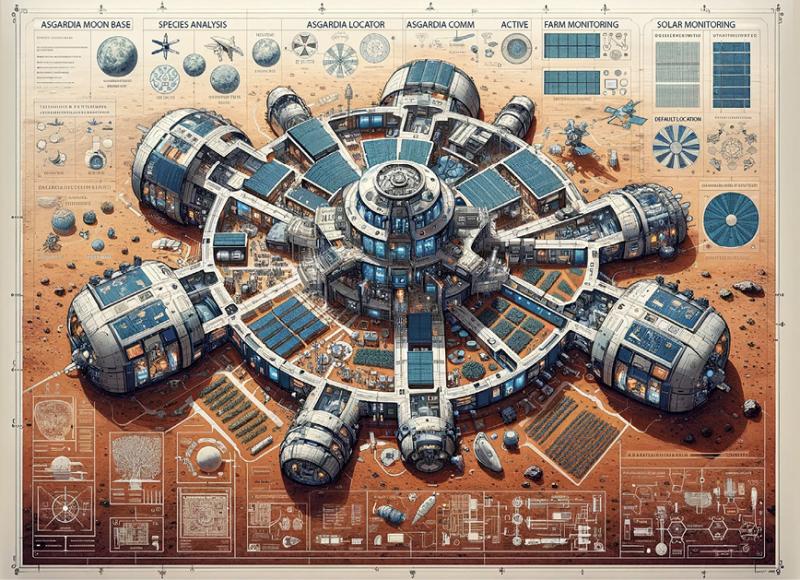 Integration of complex structures in space is based on international collaboration.
Integration of complex structures in space is based on international collaboration.
Future outlook
In a field where the margins for error are minimal and the consequences of failure potentially catastrophic, respecting best practices is not an option, but an obligation
Asgardia is currently in the process of implementing AMIA and establishing the APCI. This is a complex and challenging task, but it is essential for the long-term success of space manufacturing in Asgardia. The Ministry of Manufacturing and the Parliamentary Manufacturing Committee are working diligently to overcome challenges and ensure the success of AMIA and the APCI. They are committed to building a prosperous space manufacturing ecosystem that will enable humanity to live and work in space sustainably and for the benefit of all.
About the authors
Jacob Mulder is Minister of Manufacturing at Asgardia and ICT Security & Enterprise Architect at CGI, an IT systems integration and business consultancy. He is also chair of Paletzorg.org (a partnership of small-scale health and care companies), owner of MADmelange.com and volunteers in diversity and accessibility networks. He studied astronomy and computer science and lives in the Netherlands, but to escape gravity, which is currently keeping him in an electric reclining wheelchair due to back problems, he intends to emigrate to space some 15 years from now.
Benedetto Professo is Chair of the Parliamentary Manufacturing Committee. He is a seasoned product design professional with over 10 years of freelance experience. He is best known for designing a Nespresso coffee machine produced in quantities exceeding three million units annually. In addition to his design skills, he excels in business management and advocates for operational excellence. He is passionate about football, action movies and science fiction.
Jason Berry is Vice-Chair of the Parliamentary Manufacturing Committee and the first Deaf/Hard of Hearing Member of Parliament at Asgardia. Jason has expertise in advanced CADMD and mechanical design and owns a thriving marketing service, catering to diverse clients and investing in pre-launch companies. Jason is an advocate for inclusivity and a symbol of hope for the Deaf/Hard of Hearing community and has a passion for making space exploration accessible to everyone.





